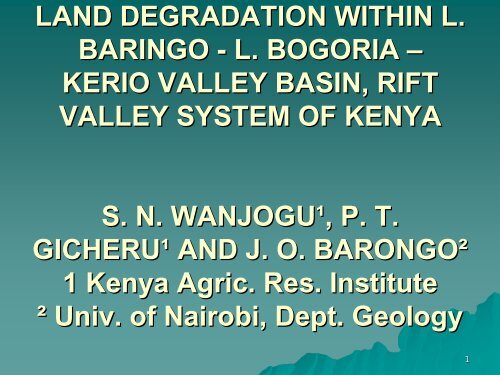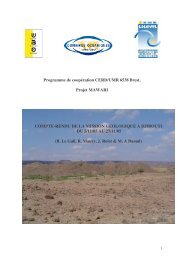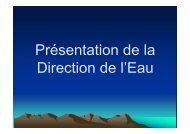land degradation baringo-bogoria - MaWaRi.net
land degradation baringo-bogoria - MaWaRi.net
land degradation baringo-bogoria - MaWaRi.net
You also want an ePaper? Increase the reach of your titles
YUMPU automatically turns print PDFs into web optimized ePapers that Google loves.
INTRODUCTION- Land <strong>degradation</strong> refers to the decline inthe productive capacity of and ecosystemdue to processes induced by human activity- Processes: erosion, salinization,sodication, waterlogging, , flooding, drought,sealing and crusting, compaction/pulverization, sedimentation and siltation- reduce quality of surface and undergroundwater2
INTRODUCTION …..CONT’D-- soil and water mgnt strategiesthat reduce/protect <strong>land</strong> from theseprocesses -> > surface andunderground water quality andquantity-understanding interaction of Cl,PM/Geo, Topo, , Org & T in soilformtn impornt in utiliz and mgnt<strong>land</strong> resources3
INTRODUCTION ….CNT’D setting guidelines to help in decision makingfor sustainable management of water andother <strong>land</strong> resources in the Rift System Leading to economic empowerment ofinhabitants for resources (water, soils andvegetation) utilization and management4
OBJECTIVETo assess the type, causes, extent anddistribution of <strong>land</strong> <strong>degradation</strong> withinthe L. Baringo-BogoriaBogoria-KerioValleyBasin and recommend appropriatemanagement intervention measures.5
WORKING METHODSLocation and environmental characteristics Area located between Lat. 0˚015’ & 0 ˚ 50’N; long. 35˚ 45’& 36˚ 15’E Covers ACZ II – V i.e semi-humidhumid-semi-arid & r/Eo 0.25 –0.65; low – high potential for plant growth; <strong>land</strong> use-agroagro-pastoralism; ; ACZ V ocvers most of the areaData collection Collection of existing information & Field information egerosion indicators Standard analytical lab methods Interpretation of field and lab data for <strong>land</strong> <strong>degradation</strong>6
RESULTSSOILS Mountains and major scarps - somewhatexcessively drained to well drained, veryshallow to very deep, dark red to strong brown,friable, stony and gravelly sandy loam to clay;(HumicNitisols and Cambisols) Hills and minor scarps – somewhatexcessively drained, very shallow to shallow,dark reddish brown, very stony, friable to firm,clay (Humic(Cambisols)7
Footslopes- well drained, shallow to deep soilsof varying colour and texture; in places rockyand stony (Eutric(Regosols and ChromicLuvisols) Up<strong>land</strong>s - well drained, shallow to moderatelydeep, dark red to brown, friable sandy clay toclay (Humic(Ferralsols, Haplic Luvisols andCalcaric Regosols)8
RESULTS ……………CNTCNT’D Plateaus- well drained, moderately deep todeep, reddish brown to dark reddish brown, clayloam to clay (Eutric(Fluvisols; Haplic Solonchak) Floodplains - well drained, moderately deep tovery deep, dark reddish brown to brown, friableto firm, silt loam to clay: in places calcareousand cracking (Calcaric(and Eutric Fluvisols,sodic and/or saline phase )9
1010EROSIONEROSIONSUSCEPTIBILITY/HAZARDSUSCEPTIBILITY/HAZARDTopographyTopographyErosionErosion SuscepSuscepErosionErosionHazardHazardMountainsMountainsModerateModerate-highhighModerateModerateHillsHillsModerateModerateModerateModerateFootslopesFootslopesModerateModerate-highhighSevereSevereUp<strong>land</strong>sUp<strong>land</strong>sLowLow-highhighModerateModerate-severeseverePlateausPlateausLowLow-moderatemoderateModerModer-severeesevereeFloodplainsFloodplainsLow to moderateLow to moderateModerModer-severesevere
SUSCEPTIBILITY TO SEALINGAND CRUSTING All the soils indicate moderate to highsusceptibility to surface sealing andcrusting Weak-moderate, 2-10mm 2thick crustsobserved on bare soils due to high Si/ClCl,low SOM and high ESP in topsoils Use of the locally available and abundantlivestock manure to improve structuralstability and hence surface sealing &crusting recommended in addition tosupplying plant nutrients11
Adherence to selective clearing whenopening new areas for cultivation byconserving indigenous vegetation. Adoption of appropriate soil andwater conservation practices(cultural and agronomic). Adoption of integrated <strong>land</strong>management incorporating agro-forestry necessary.12
SILTATION/SEDIMENTATION Dispersed/eroded soil particles deposited on<strong>land</strong>, rivers, dams, water pans and lakes. Receding level of Lakes Bogoria & Baringonoted and alluvial depopsits noted onshores. Brown colour of L.Baringo and R. Wasegesan indicator of erosion from catchment areaand deposition of sediments in the water. A belt of adaptable vegetation alongshoreline needed to act as a sieving/filteringand buffering zone. Prosopis Juliflora (Mathenge)) found to beeffective in sediment trapping and sievingalong L.Baringo13
SOIL STRUCTURE DESTRUCTIONCompaction leads to increased BD, reduced moistureholding capacity, conductivity and infiltration rates=>increased runoff and erosion.Puddling and pulverization destroys topsoil structure.Causes: overstocking, vegetation depletion, use ofheavy machinery, untimely tillage & pedogenicprocesses (natural)Management: Use of FYM, timelytillage/ploughingploughing, , deep tillage, proper carryingcapacity and maintenance of good soil cover=>improved soil productivity, quality and quantity ofsurface and groundwater. Causes: Management:14
NUTRIENTS DEPLETION AND SOILACIDIFICATION naturally occurs due to leaching ofnutrients (Ca, Mg and K) leading toacidification and Al toxicity =>ACZII&III soils are strongly acid (pH 4.7) tostrongly alkaline (pH 8.8) low pH soils indicate low %BS(
continuous planting with norotation/fallow or reducedfallowno nutrients replenishment dueto high costs of inorganicfertilizers.Limited use of FYM despite itsavailability.Use of inappropriate inorganicfertilizers.16
SALINIZATION AND SODICATION Could be naturally occuring or human induced. Vulnerability high in ACZ IV & V on cultivated<strong>land</strong> under irrigated agriculture and on soils offloodplains with sodic and/or salic phases. Use of sodic/saline irrigation water; rise insaline/sodicsodic groundwater level through seepage,overflow and over-irrigation. Occuring in Pekerra,Mukutan & Loboi irrigtSchemes due to use of saline and sodic water Use of gypsum & FYM; efficient application ofwarter (avoid over-irrigation); deep ploughing17
BIOLOGICAL DEGRADATION Controlled by climate,texture,lime, moisture & sodium content SOM decomptn governed by =>microbial activity=>temp &moisture SOM decreases ACZ II-VVegtnclearing for cultivt, , fuel wood ,charcoal & overgrazing Colonization by Juliflora prosopis18
19RECOMMENDATIONRECOMMENDATIONCONCLUSIONS ANDCONCLUSIONS AND
Selective clearing to conserveindigenous vegetation Adoption of appropriate S&Wconservation practices Use of FYM recommendedand N fertilizers Deep ploughing necessary Maintainance of livestockcarrying capacity important Res on use of Julifloraprosopis in reclamation ofsaline and sodic soilsnecessary20
CONCLUSIONS ANDRECOMMENDATIONS CNT’Dintegrated <strong>land</strong> Mangnt in thecatcment is necessaryIncreased relationship betweenresearch-extensionextension-stakeholdersstakeholderscrucial and participatoryDetailed Detailed work on trend of<strong>degradation</strong> in the basinimportant21








